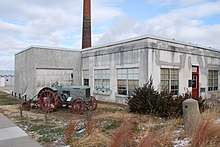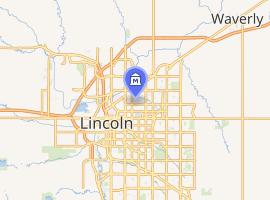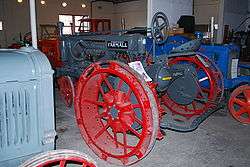Lester F. Larsen Tractor Museum
The Lester F. Larsen Tractor Test and Power Museum is a historical facility located on the East Campus of the University of Nebraska–Lincoln in Lincoln, Nebraska, United States. The museum was established in 1980 and is dedicated to preserving and documenting the history of Nebraska's tractor test law (dating from 1919) which began as a law to protect others from irresponsible tractor companies failing to keep the best interest of the farmer in mind. Today it remains the only tractor testing museum in the world. It is also still the only complete tractor test laboratory in the world.
 | |

| |
| Established | 1980 |
|---|---|
| Location | 3310 Holdrege Street Lincoln, Nebraska |
| Coordinates | 40°49′56″N 96°40′07″W |
| Type | Agriculture museum |
| Website | tractormuseum.unl.edu |
History
The Nebraska tractor testing law had its roots from 1919 when Wilmot Crozier, a farmer and legislator from Osceola in Polk County, bought a Ford 8-16 tractor. Not made by Henry Ford Co., the Ford 8-16 didn't live up to its advertised claims. The advertisements claimed it could pull three plows at once. Mr. Crozier could only get it to pull one. He took it back to the dealership and demanded they take it back, but they told him, "You own it, you keep it". They did eventually give him a Rumely H tractor The advertisements claimed it could pull three plows at once; Crozier got it to pull five. Wilmot Crozier and State Senator Charles Warner decided to ensure that all farmers would get a fair deal when buying any model of tractor sold in Nebraska. Under their leadership, the Nebraska Tractor Test Law was passed in 1919, House Roll 85. At the same time, the legislature established a facility for tractor testing on the east campus of the University of Nebraska–Lincoln to ensure that tractor manufacturers met their advertised claims of the tractors performance. The Nebraska Tractor Test Laboratory is known around the world as the first test lab in the world. And it is the leader in tractor testing and is still the only one of its kind in the world. The Lester F. Larsen Tractor Test and Power Museum is housed in the original Nebraska Tractor Test facility on the East Campus of the University of Nebraska Lincoln. It is located at 35th and Fair Streets. A newer section was built on in 1948. The building was declared a historical landmark by the American Society of Agricultural Engineers in 1980 and dedicated as a museum in 1998. Friends of the Museum were instrumental in early renovation efforts and continue to raise funds for the museum. The museum in now part of the University of Nebraska State Museum system. The Waterloo Boy tractor was the first to successfully complete the testing process in 1920. Only because of the harsh winter of 1919, they didn't get the testing finished in time.
Since 1919, the state continues to test tractors to ensure reliability standards. The test track is located directly west of the museum, and the testing facility is northwest of the museum and north of the test track. The present site of the museum was previously used as a testing garage until a larger, more capable facility was constructed. The track is 12% stronger than an airport runway, which is 12% stronger than city streets. It has two 800-foot straightaways, but during testing only 500 feet are used. They use the track to determine the drawbar horsepower of a tractor. Inside the test laboratory, they back the tractor into a dynamometer, which determines the "belt horsepower" of the tractor. The original 1919 Sprague dynamometer is housed in the museum.
Collections

The museum's collection consists of 40 antique and unique tractors, including:
- Ford 8-16
- Waterloo Boy N
- Heider C
- Moline Universal D
- Fordson 1920
- Allis-Chalmers G
- Ford 8N
- Taishan Model 12 (Which was withdrawn from testing in 1983, Now located at Rogers Memorial Farm)
- John Deere 820
- And More!
See also
References
External links
- tractormuseum.unl.edu/ — Lester F. Larsen Tractor Museum